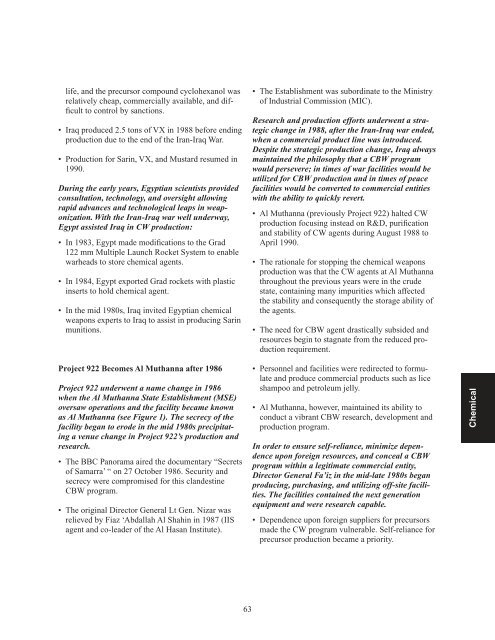Comprehensive Report
GPO-DUELFERREPORT-3
GPO-DUELFERREPORT-3
- No tags were found...
Create successful ePaper yourself
Turn your PDF publications into a flip-book with our unique Google optimized e-Paper software.
life, and the precursor compound cyclohexanol was<br />
relatively cheap, commercially available, and difficult<br />
to control by sanctions.<br />
• Iraq produced 2.5 tons of VX in 1988 before ending<br />
production due to the end of the Iran-Iraq War.<br />
• Production for Sarin, VX, and Mustard resumed in<br />
1990.<br />
During the early years, Egyptian scientists provided<br />
consultation, technology, and oversight allowing<br />
rapid advances and technological leaps in weaponization.<br />
With the Iran-Iraq war well underway,<br />
Egypt assisted Iraq in CW production:<br />
• In 1983, Egypt made modifications to the Grad<br />
122 mm Multiple Launch Rocket System to enable<br />
warheads to store chemical agents.<br />
• In 1984, Egypt exported Grad rockets with plastic<br />
inserts to hold chemical agent.<br />
• In the mid 1980s, Iraq invited Egyptian chemical<br />
weapons experts to Iraq to assist in producing Sarin<br />
munitions.<br />
• The Establishment was subordinate to the Ministry<br />
of Industrial Commission (MIC).<br />
Research and production efforts underwent a strategic<br />
change in 1988, after the Iran-Iraq war ended,<br />
when a commercial product line was introduced.<br />
Despite the strategic production change, Iraq always<br />
maintained the philosophy that a CBW program<br />
would persevere; in times of war facilities would be<br />
utilized for CBW production and in times of peace<br />
facilities would be converted to commercial entities<br />
with the ability to quickly revert.<br />
• Al Muthanna (previously Project 922) halted CW<br />
production focusing instead on R&D, purification<br />
and stability of CW agents during August 1988 to<br />
April 1990.<br />
• The rationale for stopping the chemical weapons<br />
production was that the CW agents at Al Muthanna<br />
throughout the previous years were in the crude<br />
state, containing many impurities which affected<br />
the stability and consequently the storage ability of<br />
the agents.<br />
• The need for CBW agent drastically subsided and<br />
resources begin to stagnate from the reduced production<br />
requirement.<br />
Project 922 Becomes Al Muthanna after 1986<br />
Project 922 underwent a name change in 1986<br />
when the Al Muthanna State Establishment (MSE)<br />
oversaw operations and the facility became known<br />
as Al Muthanna (see Figure 1). The secrecy of the<br />
facility began to erode in the mid 1980s precipitating<br />
a venue change in Project 922’s production and<br />
research.<br />
• The BBC Panorama aired the documentary “Secrets<br />
of Samarra’ “ on 27 October 1986. Security and<br />
secrecy were compromised for this clandestine<br />
CBW program.<br />
• The original Director General Lt Gen. Nizar was<br />
relieved by Fiaz ‘Abdallah Al Shahin in 1987 (IIS<br />
agent and co-leader of the Al Hasan Institute).<br />
• Personnel and facilities were redirected to formulate<br />
and produce commercial products such as lice<br />
shampoo and petroleum jelly.<br />
• Al Muthanna, however, maintained its ability to<br />
conduct a vibrant CBW research, development and<br />
production program.<br />
In order to ensure self-reliance, minimize dependence<br />
upon foreign resources, and conceal a CBW<br />
program within a legitimate commercial entity,<br />
Director General Fa’iz in the mid-late 1980s began<br />
producing, purchasing, and utilizing off-site facilities.<br />
The facilities contained the next generation<br />
equipment and were research capable.<br />
• Dependence upon foreign suppliers for precursors<br />
made the CW program vulnerable. Self-reliance for<br />
precursor production became a priority.<br />
Chemical<br />
63


